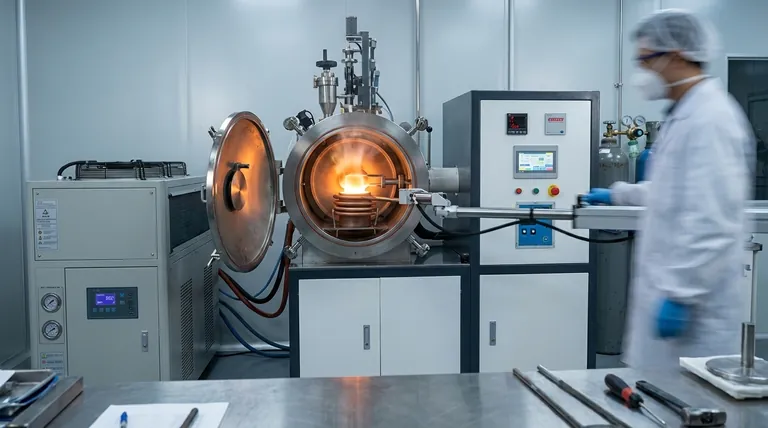Yes, an induction furnace is a primary and highly effective method for melting titanium. However, the process is far more demanding than melting common metals like steel or aluminum. Simply reaching titanium's high melting point is only the first step; the critical challenge lies in managing its extreme chemical reactivity when in a molten state.
The core issue with melting titanium is not generating heat, but preventing contamination. While an induction furnace can easily provide the necessary temperature, it must be operated within a vacuum or a controlled inert atmosphere to protect the molten titanium from reacting with the air, which would render it brittle and unusable.

The Power of Induction for High-Temperature Metals
Induction furnaces are exceptionally well-suited for melting metals with high melting points, including refractory metals like titanium.
Reaching Titanium's Melting Point
Titanium has a melting point of approximately 1,668°C (3,034°F), which is significantly higher than that of steel (around 1,370°C) or aluminum (660°C). An induction furnace generates intense heat directly within the metal itself, allowing it to efficiently reach and exceed these temperatures.
Clean and Controlled Heating
The heating process is contactless. A powerful magnetic field induces electrical currents (eddy currents) within the titanium, causing it to heat up rapidly due to its own electrical resistance. This eliminates the risk of contamination from combustion byproducts or direct contact with heating elements.
The Critical Challenge: Titanium's Reactivity
The main difficulty in melting titanium is its aggressive affinity for oxygen, nitrogen, and hydrogen at high temperatures. This reactivity is the single most important factor to manage.
The Problem with Air
If exposed to the atmosphere, molten titanium will instantly absorb oxygen and nitrogen. This forms hard, brittle compounds (oxides and nitrides) within the metal, destroying its desirable properties of strength, ductility, and corrosion resistance.
The Solution: Vacuum Induction Melting (VIM)
To overcome this, a specialized furnace known as a Vacuum Induction Melting (VIM) furnace is required. The entire induction coil, crucible, and charge material are housed inside a chamber from which the air is pumped out to create a high vacuum.
Melting under vacuum prevents the molten metal from coming into contact with atmospheric gases, preserving its purity and mechanical properties.
The Importance of the Crucible
The container holding the molten titanium, known as the crucible, is also a critical consideration. Molten titanium is so reactive it can even degrade or react with standard ceramic crucible materials. For this reason, non-reactive crucibles made of graphite or even water-cooled copper hearths (known as cold crucibles) are often used to minimize contamination.
Understanding the Trade-offs
While VIM is the gold standard for melting titanium, it comes with significant operational considerations.
System Complexity and Cost
VIM furnaces are far more complex and expensive than standard induction furnaces that operate in the open air. The vacuum chamber, high-capacity pumps, and sophisticated control systems represent a major capital investment.
Process Control Requirements
Operating a VIM furnace demands a high level of skill. The process involves managing vacuum levels, precisely controlling temperature ramps, and executing the pour within the sealed environment, often using remote manipulators or tilt-pour mechanisms.
Batch Processing Limitations
VIM is inherently a batch process. The chamber must be sealed, pumped down, the melt performed, the metal poured, and then cooled before the chamber can be opened for the next batch. This can limit throughput compared to more continuous methods used for steel production.
Making the Right Choice for Your Goal
Selecting the right melting approach depends entirely on the required purity and final application of the titanium.
- If your primary focus is high-performance alloys (aerospace, medical): A Vacuum Induction Melting (VIM) furnace is non-negotiable to ensure the required purity and mechanical properties.
- If your primary focus is alloying or less critical components: An induction furnace operating under a heavy blanket of an inert gas like argon may be considered, but the risk of contamination remains high.
- If your primary focus is ultimate purity for demanding applications: You may need to use VIM as a primary step, followed by a secondary refining process like Vacuum Arc Remelting (VAR).
Ultimately, melting titanium successfully is less about the heat source and more about mastering the environment in which it is melted.
Summary Table:
| Key Aspect | Requirement for Melting Titanium |
|---|---|
| Furnace Type | Vacuum Induction Melting (VIM) Furnace |
| Atmosphere | High Vacuum or Controlled Inert Gas (e.g., Argon) |
| Crucible Material | Graphite or Water-Cooled Copper (Cold Hearth) |
| Primary Challenge | Preventing contamination from oxygen, nitrogen, and hydrogen |
| Best For | High-purity applications (Aerospace, Medical implants) |
Ready to achieve high-purity titanium melts?
Melting titanium demands precision and the right equipment to prevent contamination and preserve material properties. KINTEK specializes in advanced laboratory equipment, including Vacuum Induction Melting (VIM) solutions, designed to meet the stringent requirements of aerospace, medical, and high-tech manufacturing.
Our experts can help you select the perfect furnace and crucible system for your specific titanium application, ensuring optimal performance and purity.
Contact KINTEK today to discuss your project and discover how our lab equipment can enhance your research and production capabilities.
Visual Guide

Related Products
- Lab-Scale Vacuum Induction Melting Furnace
- Vacuum Heat Treat Furnace and Levitation Induction Melting Furnace
- Vacuum Arc Induction Melting Furnace
- 600T Vacuum Induction Hot Press Furnace for Heat Treat and Sintering
- Vacuum Heat Treat Sintering Brazing Furnace
People Also Ask
- What are the advantages of induction melting? Achieve Faster, Cleaner, and More Controlled Metal Melting
- What is the vacuum induction method? Master High-Purity Metal Melting for Advanced Alloys
- How does a vim furnace work? Achieve Ultimate Purity in High-Performance Metal Melting
- What is VIM in metallurgy? A Guide to Vacuum Induction Melting for High-Performance Alloys
- What is the principle of vacuum induction melting? Achieve Ultra-High Purity Metals



















